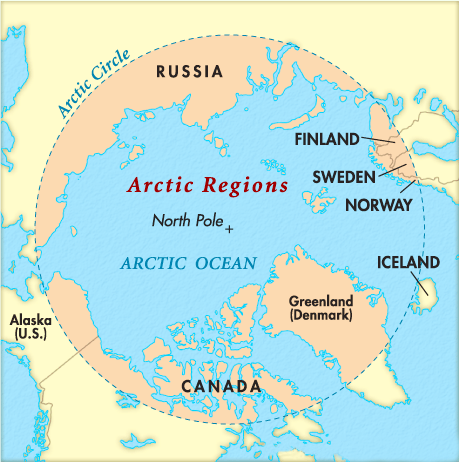Biodiversity & Environment
India's Arctic Policy
- 19 Mar 2022
- 7 min read
For Prelims: Arctic Council, Climate Change, Arctic Region, India's Arctic Policy.
For Mains: India’s Arctic Policy. Significance of Arctic for India.
Why in News?
Recently, the Ministry of Earth Science has unveiled India's Arctic Policy, titled 'India and the Arctic: building a partnership for sustainable development'.
- India holds one of the 13 positions as the Observer in the Arctic Council.
- The Arctic Council is an intergovernmental body that promotes research and facilitates cooperation among Arctic countries on issues related to the environmental protection and sustainable development of the Arctic region.
PYQ
Consider the following countries: (2014)
1. Denmark
2. Japan
3. Russian Federation
4. United Kingdom
5. United States of America
Which of the above are the members of the ‘Arctic Council’?
(a) 1, 2 and 3
(b) 2, 3 and 4
(c) 1, 4 and 5
(d) 1, 3 and 5
Ans: (d)
What is the Background?
- India's engagement with the Arctic began when it signed the Svalbard Treaty in 1920 in Paris between Norway, the US, Denmark, France, Italy, Japan, the Netherlands, Great Britain, and Ireland, and the British overseas Dominions and Sweden concerning Spitsbergen.
- Spitsbergen is the largest island of the Svalbard archipelago, part of Norway, in the Arctic Ocean.
- Spitsbergen is the only permanently inhabited part of Svalbard. More than 50% of the land is covered in ice year-round. Together with the glaciers, it is mountains and fjords that define the landscape.
- Ever since then, India has been closely monitoring all the developments in the Arctic region.
- India initiated its Arctic research program in 2007 with a focus on climate change in the region.
- The objectives included studying teleconnections between Arctic climate and Indian monsoon, to characterise sea ice in the Arctic using satellite data, to estimate the effect on global warming.
- India also focuses on conducting research on the dynamics and mass budget of Arctic glaciers and sea-level changes, carrying out an assessment of the flora and fauna of the Arctic.
What are the Major Provisions of India's Arctic Policy?
- Six Central Pillars:
- Science and research.
- Environmental protection.
- Economic and human development.
- Transportation and connectivity.
- Governance and international cooperation.
- National capacity building.
- Objectives:
- It aims to strengthen national capabilities and competencies in science and exploration, climate and environmental protection, maritime and economic cooperation with the Arctic region.
- It seeks to strengthen institutional and human resource capacities within the government and academic, research and business institutions through inter-ministerial coordination in pursuit of India’s interests in the Arctic.
- It seeks to enhance understanding of the impact of climate change in the Arctic region on India’s climate, economic and energy security.
- It aims to promote better analysis, prediction and coordinated policymaking on the implications of ice melting in the Arctic on India’s economic, military and strategic interests related to global shipping routes, energy security and exploitation of mineral wealth.
- It seeks to study the linkages between polar regions and the Himalayas and deepen the cooperation between India and the countries of the Arctic region under various Arctic forums, drawing expertise from scientific and traditional knowledge.
- The policy also seeks to increase India’s participation in the Arctic Council and improve understanding of the complex governance structures in the Arctic, relevant international laws and geopolitics of the region.
- Relevance of Arctic for India?
- The Arctic region is significant due to the shipping routes that run through it.
- According to an analysis published by the Manohar Parrikar Institute for Defence Studies and Analyses, the adverse effects of the Arctic are not just impacting the availability of mineral and hydrocarbon resources, but also transforming global shipping routes.
- According to the Ministry of External Affairs, India can play a constructive role in securing a stable Arctic.
- The region holds immense geopolitical importance as the Arctic is projected to be ice-free by 2050 and world powers making a beeline to exploit the region rich in natural resources.
What is the Arctic?
- The Arctic is a polar region located at the northernmost part of Earth.
- Land within the Arctic region has seasonally varying snow and ice cover.
- It consists of the Arctic Ocean, adjacent seas, and parts of Alaska (United States), Canada, Finland, Greenland (Denmark), Iceland, Norway, Russia, and Sweden.
Way Forward
- India’s Arctic Policy is timely and is likely to provide a direction to India’s policy-makers on contours of India’s engagement with the region.
- It is the first step towards developing a whole-of-government approach on India’s engagement with the region.
- The Policy is also likely to raise awareness about the Arctic within India and vice-versa through conduct of programmes, seminars and events in India and in the Arctic.
- However, India must also officially appoint an ‘Arctic ambassador/representative’ who will represent and voice India’s perspectives on Arctic affairs.
- Constituting a dedicated expert committee to plan, monitor, steer, implement and review India’s Arctic policy may help streamline the country’s approach in a better manner.
PYQ
The term ‘IndARC’, sometimes seen in the news, is the name of (2015)
(a) an indigenously developed radar system inducted into Indian Defence
(b) India’s satellite to provide services to the countries of Indian Ocean Rim
(c) a scientific establishment set up by India in Antarctic region
(d) India’s underwater observatory to scientifically study the Arctic region
Ans: (d)







